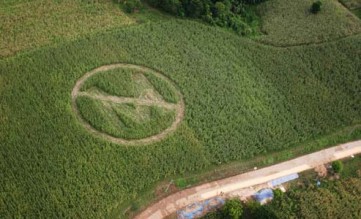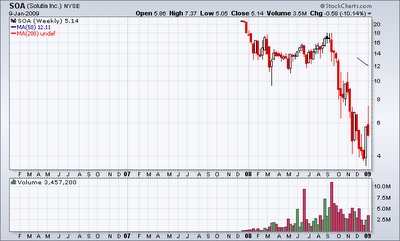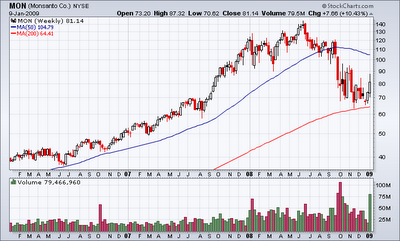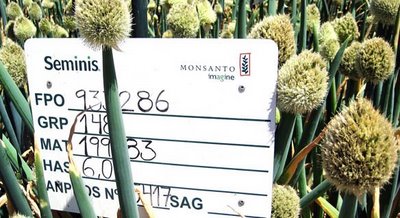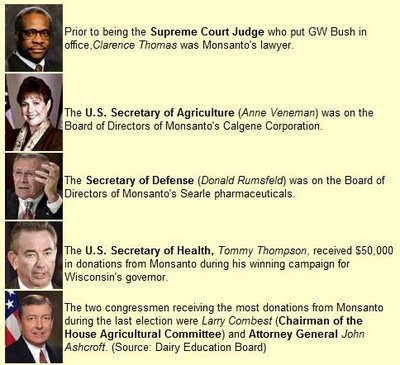
Monsanto: Profiting Without Conscience
“Monsanto is big. You can’t win. We will get you. You will pay.” –Seed Police agent
Originally this was going to be a piece on the technical merits of shorting MON, but there is a higher moral imperative here. A theme at GTM is the retail investor taking it to the man. If there’s ever an epic poster child for The Man (evil corporate entity) it is Monsanto. There are many fundamental reasons why this company should taste our steel. This article will explore some of corporatocracy’s pervasiveness, and why shorting MON could be psychologically satisfying.
This is going to be a slam piece. That’s right I said it. I’m saying it to all MON longs. Monsanto deserves to be shorted into oblivion. If you eat processed grains that are not organic, you are likely eating Monsanto genetically modified food (which is banned in Europe for safety concerns). Almost every sugar-free product on the market is a Monsanto money maker. If your snack has soybean oil in it, you are certainly drinking from the Monsanto tap–a poisoned source.
Monsanto got their start in 1901 selling saccharin to a Coca-Cola addicted public. Questions arose about the safety of saccharin, and the U.S. Department of Agriculture tried to ban it. They failed in their effort against the Monsanto lobby machine. Saccharin poisoning lead to my grandfather’s death from colon cancer. How many grandparents has Monsanto killed? Ironically, Monsanto’s founder John Francis Queeny died from cancer, possibly saccharin poisoning–poetic justice. The modern version of saccharin is sold as NutraSweet. The chemical is aspartame which Donald Rumsfeld sold to Monsanto earning $12M off the stock. The Bush Administration has been dubbed the Monsanto Cabinet for all their connections to the company. Got your attention now?
We’re going to cover a short background on Monsanto and explore why their world food production monopoly is dangerous. See our prior story on monopoly in Argentina for similar policies. The main quoted source in this article is from the Pulitzer work of Barlett and Steele published in Vanity Fair. Their story is called Monsanto Harvest of Fear.
Let’s start with the Monsanto party line:
As an agricultural and technology company committed to human rights, we have a unique opportunity to protect and advance human rights. We have a responsibility to consider not only how our business can benefit consumers, farmers, and food processors, but how it can protect the human rights of both Monsanto’s employees and our business partners’ employees. — Hugh Grant, Monsanto, Chairman, President and Chief Executive Officer
What’s so Bad About a Chemical Company?
Okay, all fine and good on the surface, but is this trustworthy. Monsanto is after all an American institution. Its safety glass protects the U.S. Constitution and its synthetic fibers are the basis of AstroTurf. However, if they’re such a great company, why did they completely rebuild their corporate image in 2002. By the late 1990s Monsanto rebranded itself into a “life sciences” company and spun off its chemical and fibers operations into a new company called Solutia. Then after additional reorganization Monsanto re-incorporated in 2002 and officially declared itself an “agricultural company.”
Check out the price history of Solutia vs. Monsanto:
It’s as though the original Monsanto, the company that long had the word “chemical” as part of its name, never existed. One of the benefits of doing this, as the company does not point out, was to channel the bulk of the growing backlog of chemical lawsuits and liabilities onto Solutia, keeping the Monsanto brand pure.
Short List of Grievances Against Monsanto:
- 1917 US government suit against Monsanto over the safety of saccharin
- 1965-1972 UK landfill illegal toxic waste dumping
- Agent Orange chemical warfare +5M people poisoned
- 1979 dioxin chemical spill Kemner v. Monsanto longest civil jury trial in U.S. history
- Responsible for 56 contaminated Superfund sites
- Anniston, Alabama mercury and PCB-laden waste discharged into local creeks over 40 years
- Terminator seeds that lead to world food shortages, poverty, and death
- Recombinant Bovine Growth Hormone Posilac (rBST) (rBGH)
- Using coercive tactics to monopolize world markets
- Pursuing 500 cases annually against customers for “seed fraud”
- Andhra Pradesh Government vs. Monsanto on India seed price fixing
- Department of Justice and SEC criminal and civil charges for international bribing
- False advertising for “biodegradable” Roundup weed killer
- India child labor abuse in the manufacture of cotton-seeds
- India farmer suicides +150,000 and counting
- Corporate tax evasion at Sauget, Illinois facility
- Campaign against dairies which do not inject bovine growth hormone from advertising
Who is Monsanto?
“If you’re talking about PCBs, Agent Orange, Bovine Growth Hormone, water privatization, biopiracy, untested/unlabeled genetically engineered organisms, or persecuting small family farmers, you’re talking about the Monsanto Corporation.” -Organic Consumers Association
Monsanto was founded on chemicals in 1901, starting with saccharin and aspirin, and continuing post-WWII with the most toxic substances ever created by man — PCBs (polychlorinated biphenyls, the stuff we once used in air conditioners) and dioxin (a by-product of creating herbicides and pesticides). And let’s not forget Agent Orange, the defoliant that deforested Vietnam and is linked to veterans’ mental and physical health problems. Monsanto’s chemical past is responsible for over 50 Superfund cleanup sites, including two of the nation’s largest in Nitro, West Virginia and Anniston, Alabama.
From 1929 to 1971, Monsanto’s Anniston works produced PCBs as industrial coolants and insulating fluids for transformers and other electrical equipment. Today, 37 years after PCB production ceased in Anniston, and after tons of contaminated soil have been removed to try to reclaim the site, the area around the old Monsanto plant remains one of the most polluted spots in the U.S. A biologist conducting studies for Monsanto in streams near the Anniston plant got quick results when he submerged his test fish. As he reported to Monsanto, according to The Washington Post, “All 25 fish lost equilibrium and turned on their sides in 10 seconds and all were dead in 3½ minutes.”
On January 1, 2002, New Year’s Day, The Washington Post carried a front page report on Monsanto’s legacy of environmental damage in Anniston, Alabama. Plaintiffs in a pending lawsuit provided documentation showing that the local Monsanto factory knowingly discharged both mercury and PCB-laden waste into local creeks for over 40 years. In a story on January 27, The New York Times reported that during 1969 alone Monsanto had dumped 45 tons of PCBs into Snow Creek, a feeder for Choccolocco Creek which supplies much of the area’s drinking water. The company also buried millions of pounds of PCB in open-pit landfills located on hillsides above the plant and surrounding neighborhoods.
Agent Orange Challenge
See if you can watch all five minutes start to finish and how it makes you feel about investing in Monsanto:
Monsanto might be most famous for its history with dioxin. Agent Orange is the code name for a powerful herbicide and defoliant used by the U.S. military in its Herbicidal Warfare program during the Vietnam War. An estimated 21,136,000 gal. (80 000 m³) of Agent Orange was sprayed across South Vietnam, netting Monsanto vast profits.
The U.S. Department of Veterans Affairs has listed prostate cancer, respiratory cancers, multiple myeloma, type II diabetes, Hodgkin’s disease, non-Hodgkin’s lymphoma, soft tissue sarcoma, chloracne, porphyria cutanea tarda, peripheral neuropathy, and spina bifida in children of veterans exposed to Agent Orange as side effects of the herbicide.
Vietnam veterans and their families who brought the original Agent Orange lawsuit 25 years ago alleged that the government “is just waiting for us all to die.” They alleged that most of those still alive would succumb to the effects of toxic exposure before the age of 65. U.S. veterans obtained a $180 million settlement in 1984, with most affected veterans receiving a one-time lump sum payment of $1,200.
Vietnamese citizens exposed to Agent Orange got a double-edge sword.
According to Vietnamese Ministry of Foreign Affairs, 4.8 million Vietnamese people were exposed to Agent Orange, resulting in 400,000 deaths and disabilities, and 500,000 children born with birth defects. This chemical has been reported to cause serious skin diseases as well as a vast variety of cancers in the lungs, larynx, and prostate. Children in the areas where Agent Orange was used have been affected and have multiple health problems including cleft palate, mental retardation, hernias, and extra fingers and toes.
In February 2004, the newly formed Vietnamese Association of Victims of Agent Orange (VAVA) filed a class action law suit in a New York court, against Monsanto. On March 10, 2005, Judge Jack B. Weinstein – who had defended the U.S. veterans victims of Agent Orange – dismissed the suit, ruling that there was no legal basis for the plaintiffs’ claims.
In June 2001 Monsanto was accused by farmers of Ninh Thuan province of pressuring them to use genetically modified seeds that resulted in corn and maize crop failures and economic ruin.
Monsanto representatives responded with demands and threats urging the authorities to take action against by the state-run Nguoi Lao Dong newspaper (The New Worker) in Saigon, which printed a story about the farmers complaints, based on research done by social scientist Bui Dac Hai.
Agent Orange activists were outraged that Monsanto had returned to haunt Vietnam. Former wartime ambassador Madame Nguyen Ngoc Dung, told CorpWatch: “We have strongly criticized officials responsible for granting a license” (to Monsanto).
The activists say that Monsanto has been assiduously cultivating technocrats inside the ministries of trade, investment and planning, who prefer to put the war totally behind them and believe that any campaign over Agent Orange undermines good trading relations with the US, and is therefore bad for business.
World Seed Domination
“Whoever provides the world’s seeds controls the world’s food supply.” -Barlett and Steele
For nearly all of its history the United States Patent and Trademark Office had refused to grant patents on seeds, viewing them as life-forms with too many variables to be patented. But in 1980 the U.S. Supreme Court, in a five-to-four decision, turned seeds into widgets, laying the groundwork for a handful of corporations to begin taking control of the world’s food supply. Since the 1980s, Monsanto has become the world leader in genetic modification of seeds and has won 674 biotechnology patents, more than any other company, according to U.S. Department of Agriculture data.
Some farmers don’t fully understand that they aren’t supposed to save Monsanto’s seeds for next year’s planting. Others do, but ignore the stipulation rather than throw away a perfectly usable product. Still others say that they don’t use Monsanto’s genetically modified seeds, but seeds have been blown into their fields by wind or deposited by birds. It’s certainly easy for G.M. seeds to get mixed in with traditional varieties when seeds are cleaned by commercial dealers for re-planting. The seeds look identical; only a laboratory analysis can show the difference. Even if a farmer doesn’t buy G.M. seeds and doesn’t want them on his land, it’s a safe bet he’ll get a visit from Monsanto’s seed police if crops grown from G.M. seeds are discovered in his fields.
Monsanto’s fierce reputation for enforcing its patents and suing anyone who allegedly violated them. They go after farmers, farmers’ co-ops, seed dealers—anyone it suspects may have infringed its patents of genetically modified seeds. As interviews and reams of court documents reveal, Monsanto relies on a shadowy army of private investigators and agents in the American heartland to strike fear into farm country. They fan out into fields and farm towns, where they secretly videotape and photograph farmers, store owners, and co-ops; infiltrate community meetings; and gather information from informants about farming activities. Farmers say that some Monsanto agents pretend to be surveyors. Others confront farmers on their land and try to pressure them to sign papers giving Monsanto access to their private records. Farmers call them the “seed police” and use words such as “Gestapo” and “Mafia” to describe their tactics.
Investigators will say, “Monsanto knows that you are saving Roundup Ready seeds, and if you don’t sign these information-release forms, Monsanto is going to come after you and take your farm or take you for all you’re worth.” Investigators will sometimes show a farmer a photo of himself coming out of a store, to let him know he is being followed.
“Monsanto spends more than $2 million a day in research to identify, test, develop and bring to market innovative new seeds and technologies that benefit farmers,” Monsanto spokesman Darren Wallis wrote in an e-mailed letter to Vanity Fair.
What they don’t say is how most of their products have no independent testing. They tell you everything they make is safe and will save money, they submit it to the FDA for a rubber stamp, and their claim goes unchallenged until people get sick or die. When Monsanto faces blowback they pull out all the stops to block the truth.
Their 2008 annual report shows $5B in sales on Roundup and $6.4B in sales on seeds. Monsanto’s environmental and litigation reserve is $272M, roughly half the cost of yearly R&D. They spent over $6M in 2008 lobbying in Washington, D.C. which puts MON in the upper tier of corporate lobbying.
Of the many forms of suffering Monsanto has spread across the globe the latest is starvation. Every day, almost 16,000 children die from hunger-related causes–one child every five seconds. Today our world is home to 6.6 billion people. In 2005, almost 1.4 billion people lived below the international poverty line, earning less than $1.25 per day. They can not afford to purchase food from an international corporation, nonetheless buy suicide seeds Monsanto pushes through a monopoly system. This is corporate bio-warfare targeting defenseless people. Selling seeds that die after one harvest while destroying indigenous crops is a massive global crime. Part of the sad irony is America has turned into the oppressor it fought a Revolutionary War against.
What is Corporatocracy?
This beauty of eternal Calvin wisdom was written over 15 years ago about the auto industry. It still applies today, as it applies to Monsanto.
John Perkins was quoted in our prior story about the banking industry. What he warns of will be featured in Clive Owen’s new movie The International.
The majority of the people in the United States have no idea that we are living off the benefits of a clandestine empire. That today there`s more slavery in the world than ever before. And then you have to ask yourself, ‘Well if it’s an empire, then who’s the emperor?’… We do have what I consider to be the equivalent of the emperor, and it`s what I call the Corporatocracy… At the very top of the corporatocracy you really can`t tell where the person`s working, for a private corporation or the government, because they’re always moving back and forth. So, you know, you’ve got a guy who one moment is the president of a big construction company, like Halliburton, and the next moment he’s Vice President of the United States.” -John Perkins
A Monsanto official told the New York Times that the corporation should not have to take responsibility for the safety of its food products. “Monsanto should not have to vouchsafe the safety of biotech food,” said Phil Angell, Monsanto’s director of corporate communications. “Our interest is in selling as much of it as possible. Assuring its safety is the FDA’s job.”
It would be nice to think the FDA can be trusted with these matters, but think again. Monsanto has succeeded in insuring that government regulatory agencies let Monsanto do as it wishes.
Take a look:
Rumsfeld was chairman and C.E.O. of the pharmaceutical maker G. D. Searle & Co. when Monsanto acquired Searle in 1985, after Searle had experienced difficulty in finding a buyer. Rumsfeld’s stock and options in Searle were valued at $12 million at the time of the sale.
They even had L. Paul Bremer (the guy who headed Iraq between the fall of Saddam and the time the elected government took over) order that “farmers shall be prohibited from re-using seeds of protected varieties.” And we wonder why Iraqis are struggling to appreciate American intervention.
The list of other connections runs long and deep. Several staff attorneys held positions at the FDA and EPA with the common theme of: “Work for Monsanto, get a cushy job in the government for long enough to promote Monsanto products like GMOs or growth hormones, then go back to Monsanto.”
Two standouts, however, are Don Rumsfeld and Clarence Thomas. Thomas, once a lawyer for Monsanto and now Supreme Court Justice, helped steer a patent-rights case through the high court, benefiting Monsanto and other seed companies that tinker with nature.
But that harm was done by the “Original Monsanto Company,” not “Today’s Monsanto Company” (the words and the distinction are Monsanto’s). The Monsanto of today says that it can be trusted—that its biotech crops are “as wholesome, nutritious and safe as conventional crops,” and that milk from cows injected with its artificial growth hormone is the same as, and as safe as, milk from any other cow.
Final Thoughts
They said saccharin was perfectly safe. They said dioxin was perfectly safe. They say Roundup Ready genetically modified (GM) food is safe, but every living thing near it dies. Monsanto products are historically plagued with cancer fallout. One of their most egregious acts is refusal to account for the 3.5M people currently suffering from dioxin poisoning, or acknowledge those who died from Agent Orange. Still trustworthy and worth giving money to?
Monsanto’s CEO says they are a company committed to the protection and advancement of human rights. What he means is Monsanto is committed to the control of those “rights”. Taking food away from humanity to feed livestock and fill gas tanks is barbaric policy. It makes sense if the policy is designed to kill people and reduce world populations. This is a dark subtext to Monsanto’s game plan.
They are selling genetically modified seeds which kill indigenous crops, creating a world monopoly controlling food supply, and driving farmers to suicide. It’s my understanding that GM and Roundup Ready seeds do not increase yield over time, but show a bell curve yield. Transgenic cotton, and other GM seeds, are prone to viral infection and crop failure. Also ground saturated in Roundup poisons future crops and surrounding wildlife. These products destroy eco-diversity.
Another critical issue is destruction of generational planting seeds, like corn in Mexico. Their indigenous seeds become contaminated with Monsanto GM seeds subsidized by the U.S. which is forced into local fields.
All this boils down to Monsanto controlling too much of the world’s food supply. This is more powerful than using bombs or guns. They control the food so they control the people. With this food hegemony they can marginalize with impunity, which is being done in India, Mexico, and S. America. The policy of Monsanto is to inflame bio-warfare with viral GM seed infestation. Taken to the extreme farmers will not be able to save seed or continue sustainable agriculture. Monsanto says they are a food company. Are they profiting by feeding or killing?
Sources:
Vanity Fair
May 2008
by Donald L. Barlett and James B. Steele
Monsanto Seed Police | Big Brother is Watching
May 6, 2008
Agent Orange Victims Sue Monsanto
http://www.corpwatch.org/article.php?id=11638
http://en.wikipedia.org/wiki/Agent_Orange
http://www.purefood.org/monlink.html
http://www.monsanto.com/responsibility/human_rights.asp
http://www.organicconsumers.org/articles/article_14926.cfm
http://www.monsanto.com/pdf/pubs/2008/annual_report.pdf
http://www.bread.org/learn/hunger-basics/hunger-facts-international.html
http://news.bbc.co.uk/2/hi/business/4153635.stm
http://www.combat-monsanto.co.uk
March 23, 2010
(1/7/09)
www.gamingthemarket.com/monsanto-profiting-without-conscience.html

